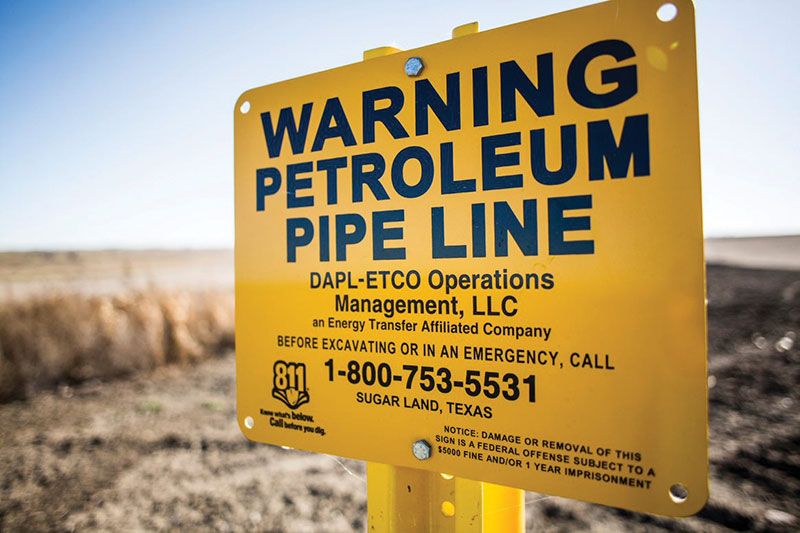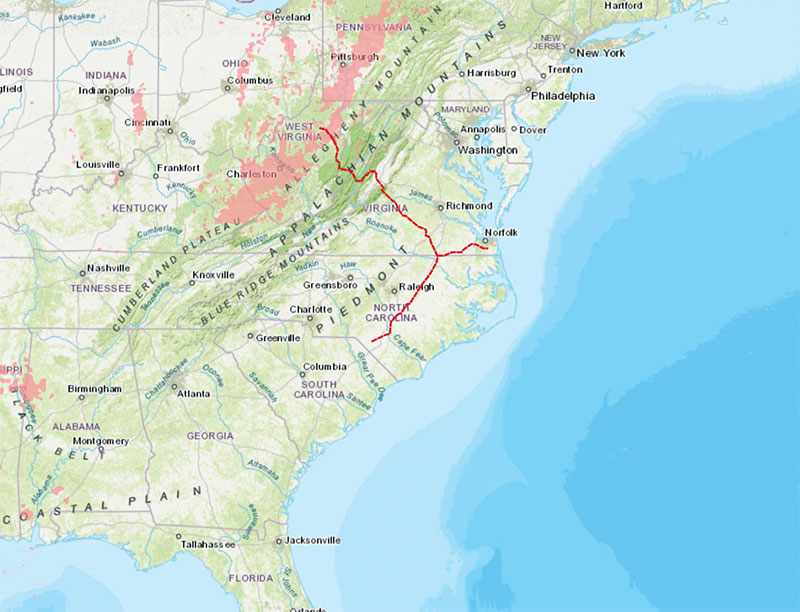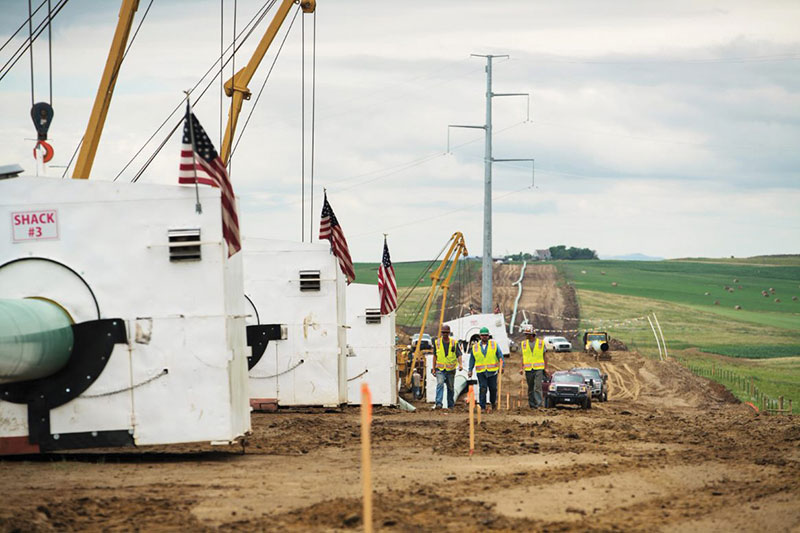September 2020, Vol. 247, No. 9
Features
Anatomy of Frustration: Atlantic Coast and Dakota Access Pipelines
By Richard Nemec, Contributing Editor
Immediately after the July 4th holiday, with COVID-19 resurging through parts of America, several indelible milestones marked the U.S. pipeline industry as another kind of scourge. Over little more than a 24-hour period, sponsors Dominion Energy and Duke Energy pulled the plug on the $8 billion proposed Atlantic Coast Pipeline (ACP), and Dominion sold nearly $10 billion of transmission/storage assets to billionaire Warren Buffett’s Berkshire Hathaway energy unit.
Meanwhile, the U.S. District and Appellate Courts for the District of Columbia ordered the $3.2 billion 1,172-mile (1,886-km) Dakota Access [oil] Pipeline (DAPL) shut down for environmental reasons later to have the appellate court stay the order.
Originally proposed in 2014, ACP’s estimated costs doubled, and its delayed construction start stretched to three and a half years. So, a favorable 7-2 U.S. Supreme Court decision this year on federal land issues favoring the project was not enough to overcome growing uncertainty and anticipated further delays in the 600-mile (966-km) project from West Virginia’s Marcellus Shale play, through Virginia to eastern North Carolina.
“This was a necessary decision given the legal uncertainties facing the project, and we deeply regret that we were unable to complete this project,” Dominion and Duke said in a joint statement released at the time. “The ACP was developed to meet the needs of communities across our region and to support the transition to cleaner energy.”
On a conference call in early July following the decision to drop ACP, Dominion CEO Tom Farrell indicated that developments following the favorable Supreme Court decision had “created an unacceptable layer of uncertainty and anticipated delays” in the long-standing project. Specifically, Farrell called out the decision by the U.S. District Court for the District of Montana overturning the Nationwide Permit 12 (NWP 12) program for streamlining federal permit authority for water and wetlands crossings by pipelines.
“This new information and litigation risk, among other continuing execution risks, make [ACP] too uncertain to justify investing more shareholder capital,” Farrell told analysts on the conference call. During the call, he also explained the strategy and rationale for selling the transmission/storage assets as a move to narrow its focus on a highly rated group of gas and electric utilities and to create a clean energy juggernaut over the next 30 years. He calls Dominion’s portfolio “premier state-regulated, sustainability-focused utilities that operate in some of the most attractive regions in the country.”
Farrell and Duke CEO Lynn Good said that legal challenges to the project’s federal and state permits caused “significant project cost increases and timing delays,” noting that the lawsuits and decisions sought to “dramatically rewrite decades of permitting and legal precedent, including as implemented by presidential administrations of both political parties.”
As a result, ACP project cost increased to $8 billion from the original estimate of $4.5 to $5 billion. In addition, the most recent public estimate of commercial in-service in early 2022 represents a nearly three-and-a-half-year delay with uncertainty remaining.
“This announcement reflects the increasing legal uncertainty that overhangs large-scale energy and industrial infrastructure development in the United States. Until these issues are resolved, the ability to satisfy the country’s energy needs will be significantly challenged,” the two company leaders noted. Nevertheless, both companies exhibited resiliency in the aftermath with Dominion selling most of its transmission storage assets for nearly $10 billion, and Duke committing to continue its clean energy transformation strategy without ACP, but with a multiyear $56 billion capital investment program.
Charlotte, N.C.-based Duke spokesperson Tammie McGee calls ACP’s termination a “missed opportunity.” What was missed were the new jobs, regional economic expansion and greater electric/gas reliability, she said, citing the loss of thousands of jobs, millions of dollars of tax revenues and more economic development, particularly in eastern North Carolina. “ACP was an ideal solution to meet the energy needs for customer and regional growth.”
Ultimately, the region is still looking for gas infrastructure and alternative supplies. Options Duke is looking at include additional pipeline and compressor infrastructure.
Around the same time, Deloitte released its midyear 2020 oil and gas outlook, and it didn’t paint a pretty picture, noting that COVID-19 has disseminated global financial and commodity markets as domestic U.S. gasoline demand fell 45%. Jet fuel was even worse because commercial flights plunged 80%.
“The decline in energy demand appears to have no parallels; the drop in jet fuel consumption has been twice as deep and substantially more prolonged than after U.S. flights were canceled in the aftermath of 9/11 in September 2001,” the outlook noted.
Deloitte predicted that the second half of 2020 might be as equally challenging as the first six months, urging oil and gas companies to tackle three specific challenges: (1) in the face of low prices and demand, permanently lower firms’ cost structure; (2) facing more uncertainty, perfect the organizational ability to ramp operations up and down rapidly to meet rapidly changing external conditions; and (3) don’t depend too heavily on shale productivity gains, offsetting lower future capital investments.
In Washington, D.C., at the Interstate Natural Gas Association of America (INGAA), the trade group for the major U.S. long-haul pipelines, officials are convinced that regulatory certainty and permitting predictability can be and should be in place as at least part of the solution to what killed the ACP project. In addition to pledging to continue to work with policymakers, INGAA members “work diligently” on an ongoing basis with landowners to ensure respectful treatment and regulatory compliance.
INGAA doubles as an active booster for natural gas, which is now being written off in some sectors as not conducive to a carbon-neutral future for U.S. energy. INGAA Spokesperson Amy Conway reiterates the organization’s conclusion that “America will need new energy infrastructure investments to help grow the economy and achieve important environmental goals.” She said writing off natural gas is “exactly the wrong thing to do.”
Conway thinks INGAA has come down hard against the abandonment of the ACP project, noting that “Duke and Dominion worked overtime to accommodate community feedback and ensure that ACP could be built and operated in an environmentally sustainable way, and consumers, manufacturers and communities that would have benefited from reliable access to domestically produced gas will now need to look elsewhere to meet their energy needs.”
INGAA champions pipelines as the safest way to move energy, and it makes the case that as the United States moved to more use of renewable energy sources, gas and its related infrastructure will be needed to ensure U.S. energy reliability.
“There were at least six years of work and effort, and I think companies like Duke and Dominion pretty much know what they are getting into working with stakeholders. They are usually good at considering and addressing any concerns,” said Ryan Wobbrock, vice president and senior credit officer for global infrastructure at Moody’s Investors Service in New York.
Among many culprits, excessive permitting requirements is the common cause most often pointed to for ACP’s demise. In fact, Moody’s Wobbrock said he is surprised that the project hung on as long as it did. Since the project’s inception in 2013-14, there has been a steady rise in involvement by environmental groups in major energy infrastructure ventures.
“The permitting obstacles and continuing court challenges are what really pushed Dominion and Duke to make the decision they did to cancel ACP,” said Wobbrock. “It increasingly has become much more difficult to permit these projects. It was always tough in building long-haul pipelines or electric transmission lines. For these projects, the hard part is always the permitting, and that’s why these projects tend to have higher returns on equity (ROE).”
An earlier U.S. Supreme Court ruling upheld an injunction on NWP 12 in place for the northern Keystone XL pipeline, while the U.S. Army Corps of Engineers appealed a lower court order to vacate the project’s approvals to the U.S. Court of Appeals for the 9th Circuit, and potentially, to the Supreme Court. Southern District of Montana Judge Brian Morris in April vacated the NWP 12 water-crossing authorizations issued by the Corps.
Calgary-based TC Energy said that it remains committed to the future of the XL pipeline project, even though court filings indicate that refusal to restore the Keystone XL permit would delay most U.S. construction until 2021. “We will continue to evaluate our 2020 U.S. scope. In Canada, our work in 2020 remains unchanged,” a TC Energy spokesperson said.
Regarding other projects, the American Petroleum Institute (API) applauded the Supreme Court’s decision to reinstate NWP 12, deeming it a “significant step toward restoring more certainty for energy companies.”
A different set of challenges faced DAPL as a fully built and operating three-year-old oil pipeline covering some of the adjacent real estate to the east of Keystone XL’s northern route. After separate District of Columbia federal courts ordered the pipeline shut and then opened, DAPL was flowing Bakken crude supplies to the Gulf Coast through July when this report was compiled. Dallas-based Energy Transfer, DAPL’s backer, maintains that any shutdown order is unsupported by law or the facts of the case. A shutdown exceeds the courts authority, attorneys for Energy Transfer contend.
A company spokesperson, Vicki Granado, emphasized that the economic implications of a shutdown “are too big to ignore, so the pipeline will do all it can to continue operations in the face of the legal challenges to the U.S. Army Corps of Engineers from Native American tribal interests in DAPL’s water crossing at a dammed portion of the Missouri River in North Dakota.
“DAPL is the only direct pipeline from North Dakota to the distribution hub in Patoka, Ill., from where Bakken-produced crude oil is transported to refineries throughout the Midwest and the Gulf Coast,” Granado said at the time of the court actions.
In late July, she reiterated that DAPL can currently transport up to 570,000 bpd, but Energy Transfer does not provide flow data on any of its pipelines. “Finally, there is no way I can speculate as to the timing of the legal proceedings,” Granado added.
“ACP didn’t have as much headline visibility as DAPL; there wasn’t as much of that local opposition in a headline-grabbing way,” Moody’s Wobbrock said. “There were pockets of that obviously, but I think what was more disruptive for ACP was the high-level opposition in the courts, and the environmental groups ability to really keep things penned up in the courts for quite some time. It seemed for every step forward the ACP pipeline could make moving forward, a counterattack would happen, causing two steps back.”
In a matter of an hour or two after ACP’s cancellation hit the news wires in the middle of a Fourth of July weekend, API and North America’s Building Trades Unions (NABTU) released a joint statement saying the action will hurt American working families. A day later the Labors’ International Union of North America (LiUNA) declared that the ACP cancellation was “another example of a broken process that is killing construction jobs.”
More recently, NABTU released two studies showing greater opportunities and higher value training, safety, health and compensation that exits in energy construction jobs.
“The reports’ findings demonstrate that today’s oil and natural gas jobs are better for energy construction workers across the country in both the short and long terms,” said Sean McGarvey, NABTU president. “The career opportunities for renewables are nowhere near what they are for oil and gas.”
The industry supports roughly 10.9 million jobs, noted McGarvey, who also blasted the court-ordered DAPL shutdown as “wrong for workers and wrong for national energy security.”
McGarvey and NABTU hope the two studies – qualitative and quantitative – will serve as “a cautionary note” to elected officials, policymakers and activists alike. “Oil and gas jobs are high-quality, and as we rebuild the economy and transition, we need a plan to rebuild the middle class with family-sustainable wages, training and growth opportunities.”
Salt Lake City-based Cicero Group conducted the qualitative study, “Perspectives and Comparisons of Job Quality Across the U.S. Energy Industry,” and University of Utah economic professor, Peter Philips, completed the quantitative work, “The Quality of Jobs in Construction and Oil and Gas for High School Graduates.”
They underscore the socioeconomic benefits that projects like DAPL and ACP bring to states and regions of the nation.
Beyond the arduous work on both sides of the energy infrastructure debate, there is growing support for decarbonization, pointing toward a future in 30 to 40 years without fossil fuels. The movement cannot be ignored by the midstream sector any more than it can ignore the National Environmental Policy Act (NEPA), which is at the heart of the legal battles over DAPL and ACP. Energy Transfer has estimated a shutdown of DAPL would cost it $1 billion, and impact on North Dakota and Bakken Shale producers could be multiple billions of dollars.
Albert Wynn, an advisor to the pro-infrastructure coalition, Grow America’s Infrastructure Now (GAIN), in an industry essay in late July noted that the federal court decision shortchanged millions of U.S. consumers who depend on affordable and reliable energy.
“The economy is now waking from its coronavirus-induced slumber with a need for energy, [so] the last thing we need is a significant, and unnecessary, disruption in what is the best mode for transporting fuel,” Wynn wrote for RealClear Energy. A shutdown will not stop the demand for the oil; it only means alternative, less safe and economic means will be used to ship it, he argued.
Legal, NWP 12 and NEPA fights will continue for the foreseeable future no matter whether there is a change or not in the White House next year. Since 2017, the Army Corps of Engineers has issued thousands of permits under the streamlined NWP 12 process with little or no regard for the NEPA’s requirements for examining the repercussions of an oil or liquids spill or gas leak. Environmental opponents seize this as a legal reason to walk back the permits, as has happened to Keystone XL in Montana.
Industry insiders are predicting more push back against Federal Energy Regulatory Commission (FERC) permitting processes in the backdrop of uncertainty and bottlenecks expected after ACP, Keystone XL and DAPL’s experiences this year. Still major projects like the Mountain Valley gas pipeline from the Marcellus Shale to the southeastern U.S. is still on track; Energy Transfer continues to push ahead with plans to nearly double DAPL’s capacity at a time when its current 500,000 bpd is threatened in the courts; and although Keystone XL was excluded, the U.S. Supreme Court did allow the Army Corps of Engineers to continue issuing NWP 12 permits for other projects.
When industry observers stand back from the daily ground-level skirmishes, what they see broadly dating back before the 2016 presidential elections is the stuff Hollywood thrives on: conflict, mystery, pathos, ethos and passion spilling over into courtrooms and board rooms. Two years ago, the Washington, D.C., reporters for McClatchy Newspapers captured some of the intrigue when they reported on Russia’s covert activities, stirring up public dissent against the joint venture Sabal Trail gas pipeline, a 517-mile (832-km) line traversing from Alabama through Georgia and into Florida, which has been transporting 1 Bcf/d (28 MMcm/d) of Marcellus gas supplies for the past three years.
Nevertheless, the McClatchy report shined a light on Russia’s state TV (RT) and its efforts to stir resentment during construction in Florida as part of a broader effort to undermine U.S. oil and gas production, which had surpassed the Russians in global production of both fuels. The McClatchy report in May 2018 was full of trolls, spies, Russian troll front organizations with innocuous titles and viral social media messages aimed at undermining the shale-driven U.S. energy revolution. At the same time, unaware U.S. environmental activists were creating social media networks for anti-Sabal Trail protesters. Russians knew how to hijack these legitimate efforts.
With the disruption of the coronavirus and the global demand crash, there is no guarantee that more ACP-like infrastructure cancellations will not follow this year and next. Dominion’s Farrell said on a conference call July 6, “Permitting for investment in gas transmission and storage has become increasingly litigious, uncertain and costly. This trend, though deeply concerning for our country’s economic growth and energy security, is a new reality.”
Later in that same call with analysts, Farrell talked about $55 billion in future Dominion growth capital aimed at reducing the company’s carbon footprint and achieving zero-carbon generation and storage. Post-ACP, Duke is eyeing a similar strategy. If the optimists are correct in believing it is “always darkest before the dawn,” then Dominion and Duke are looking past today’s struggles and seeing a lot of sunshine ahead.
Richard Nemec is P&GJ’s Los Angeles-based correspondent and regular contributor. He can be reached at: rnemec@ca.rr.com.








Comments